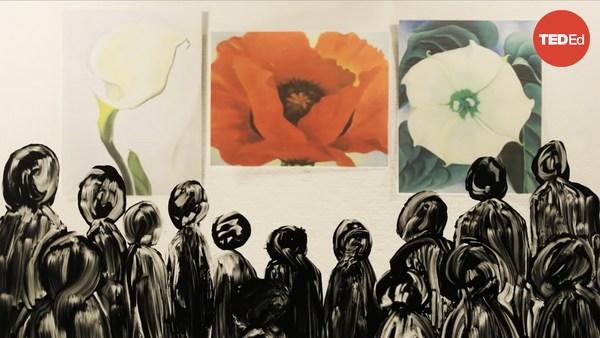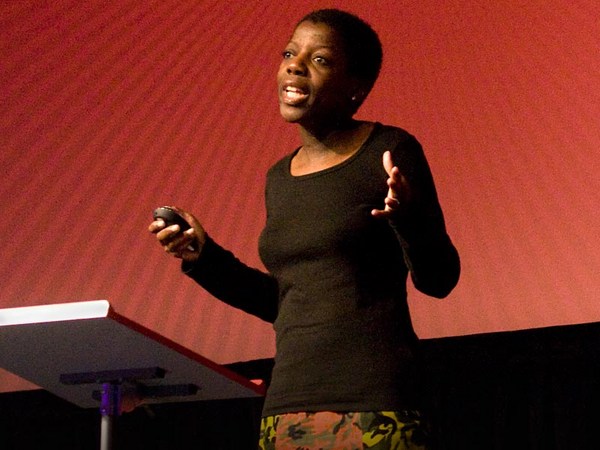I have a challenge for you. The next time you're stuck in traffic, take a minute to take a look at the sea of cars around you. How many car companies do you think you could recognize? I'm not even really into cars, but I think I'd do fairly well. But then look beyond the cars to the trees that line the side of the road. How many of those could you identify? Probably not as many, right?
Year upon year, we grow further and further away from nature to the point where we have to question: What experience of nature will the next generation have? And if that generation lacks a sort of emotional connection with their surroundings, then will they bother to fight and save it when we need it most?
My name is Nirupa Rao, and I'm a botanical artist. In short, that means I paint plants, usually with watercolor, in a way that aims to be not only aesthetically appealing but also scientifically accurate. And I'm well aware that this is quite an odd profession for a 21st-century urban Indian -- some might say outdated in the age of the camera -- but here's how my journey began.
A few years ago, I met two naturalists who work with the Nature Conservation Foundation: Divya Mudappa and T.R. Shankar Raman. And now interestingly, they actually began their careers working with animals, but they soon came to realize that if they were to protect those animals, they'd also have to protect their habitats -- that is, the trees they live off. And so they started a rainforest restoration program aimed at growing local trees that local birds and animals rely on. And they were looking to visually document them in some way, but the photographers they approached came up empty-handed. These trees were up to 140 feet tall. That's 26 times my height. Try capturing giants like that in a single camera frame. Besides, the surrounding greenery was just too dense to clearly isolate a single tree. And so together, we decided to give good old painting a shot.
And to tell you the truth, even when I was standing there right in front of them, it was difficult to see the entire tree. So instead I'd study the buttress up close and then climb up the hill to see its crown rising above the canopy. And then with Divya, and she there as aide, we could piece these pieces of the puzzle together into the final painting.
For a lot of people who don't know the jungles as well as these naturalists, these paintings are the only way that they'll get to see these trees in their entirety. We were able to document 30 of the region's most iconic species along with their fruit, flowers, seeds and leaves.
(Applause)
Through this process, the jungles really came alive to me. They morphed from this undifferentiated sea of green into individual species with individual characters. And I think a lot of people just tend to see plants as background scenery, assuming that their immobility makes them uninteresting. But I began to see that it is that very rootedness that makes them fascinating, the ingenious ways in which they adapt and respond to threats and opportunities on timescales that make our heads hurt to imagine. And I couldn't help but wonder: What if I could tell their stories, showcase their complexity? Perhaps we'd all start to think of plants a little differently.
And in fact, in my family, plants have always been a source of fascination. My grand-uncle, Father Cecil Saldanha, was the first to document the flora of our home state of Karnataka back in the '60s. And my mother has all of these memories of being a little girl watching this entire enterprise unfold. And consequently, I've come to associate plants with adventure and discovery and excitement. And so I knew I didn't just want to paint roses and sunflowers. I wanted to paint the kinds of plants that botanists like my uncle work with. And so I set out to create a book, supported by the National Geographic Society, on the weirdest, wackiest plants we could find in one of the most biodiverse regions in the world: India's very own Western Ghats.
(Applause)
Take a look at these fantastic jewel-like sundews. They grow in regions where nutrient content in the soil is poor, and so they have a little way of supplementing their diets. They lure, trap and ingest insects using mucilaginous glands on their leaves. The little insects are attracted to the sweet secretions, but once they come in contact, they are ensnared and the game is up. And you might notice that the sundews very cleverly hold their flowers on tall, thin stems high above their murderous leaves to avoid trapping potential pollinators.
Further inside the jungle, you might meet the strangler fig. It grows in areas where sunlight is scant and competition is intense. And so it has a strategy to sort of cut in line and get ahead. You see, its seeds are dispersed by birds that drop them atop the branches of existing trees. And that little seed will start to germinate from there, sending its shoots upward to the sky and its roots all the way down to the ground, all the while strangling the host tree, often to death. And even if that host tree dies and rots away, the strangler will persist as a hollowed-out column of roots and branches.
And if that didn't impress you, let me show you one of my personal favorites: the Neelakurinji. When it blossoms, it does so in unison, covering entire hillsides in carpets of blue. This is its pollination strategy known as "gregarious flowering," in which it invests all of its resources into a single, spectacular event aimed at attracting pollinators to the feast -- which is easily done, considering the Neelakurinji is all that can be seen for miles around. But here's the catch: it happens only once every 12 years.
(Applause)
And soon after seeding, these flowers will die, not to be seen again for the next 12 years.
This is our way of telling a story of the Western Ghats: through plants and through their ecosystems and the various ways in which they interact with players in their habitats. It's glorious, isn't it?
But the way things are going, we can't be sure that the Neelakurinji will come out to play again in the next 12 years. The further and further we grow from nature, the more we are almost literally blind to it and the effects that our activities have on it. And that's what it's called -- "plant blindness": the increasing inability to really register the plants around us as living beings. The two scientists that coined this term, Elisabeth Schussler and James Wandersee, contend that plants lack certain visual cues. They don't have faces, they don't move, and we don't perceive them as threats. And so with the increasing onslaught of information that our eyes receive, we just deprioritize registering plants, simply filtering out information that we view as extraneous.
But stop to think about that. Are plants really extra? Are they just nature's backdrop? Or are they the fundamental building blocks upon which all life is based, the starting points of our ecosystems and the reason why earth is sustainable for life to this day?
I leave you with these images from a program called "Wild Shaale," which in Kannada means "wild school." It's run by a conservationist, Krithi Karanth. And her team turned some of my illustrations into games that village children could play with and learn from. And I can tell you they were so excited to see plants that they recognized -- the trees that the monkeys play on, the flowers they use at their harvest festival, the fruit they use to wash their hair. And it's that sort of familiarity which, when celebrated, turns to love, which then turns into an urge to protect.
It's really time we open our eyes to the world around us, to this entire kingdom that's hidden in plain sight. And so the next time you're stuck in traffic, you know what to do.
(Applause)





